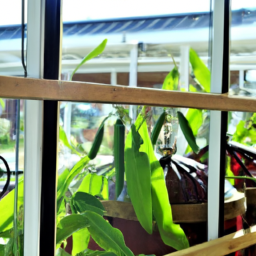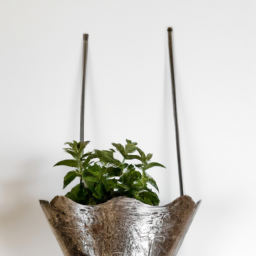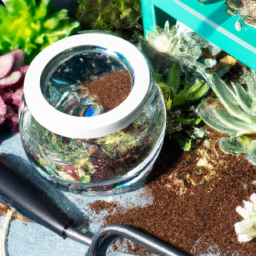
Hey there plant lovers! Are you looking for a fun and creative way to bring nature indoors? Look no further than DIY terrariums: building mini ecosystems with plants! Terrariums have become increasingly popular in recent years as a way to create your own little green oasis right in your own home. Whether you have a green thumb or are just starting out with plants, terrariums offer a low-maintenance and visually stunning way to display your favorite flora. In this blog post, we will explore the fascinating world of DIY terrariums, from the basics of building one to the different types of plants that thrive in these mini ecosystems. So, grab your gardening gloves and let’s dive into the wonderful world of DIY terrariums!
The Basics of DIY Terrariums: A Step-by-Step Guide to Building Mini Ecosystems with Plants
Welcome to the wonderful world of DIY terrariums! Whether you are a seasoned plant enthusiast or just starting on your green thumb journey, building your own mini ecosystem is a rewarding and creative endeavor. In this step-by-step guide, we will explore the basics of creating a DIY terrarium and provide you with all the information you need to get started.
Choosing the Right Container
The first step in building your own DIY terrarium is selecting the right container. Terrariums can be made in various types of glass containers, such as jars, fish tanks, or even old light bulbs. The choice of container depends on your personal preference and the size of the plants you want to include. However, keep in mind that the container should have a lid or be able to be covered to create a sealed environment.
When selecting a container, ensure it is clean and free of any chemicals or residues that could harm your plants. You can use soap and water to wash the container thoroughly, and if necessary, use a diluted bleach solution for sterilization. Rinse the container well to remove any traces of cleaning agents before moving on to the next step.
Once your container is clean and ready, it’s time to move on to the next step: creating the perfect environment for your terrarium.
Creating the Perfect Environment
A terrarium is essentially a self-contained ecosystem, so it’s crucial to create the right environment for your plants to thrive. The three main components to consider are soil, drainage, and moisture.
Soil
Choosing the right soil is essential for the success of your terrarium. Opt for a well-draining soil mix specifically formulated for indoor plants. Avoid using garden soil, as it may contain pests or diseases that can harm your plants. You can easily find pre-mixed terrarium soil at your local garden center or create your own by combining equal parts of potting soil, sand, and perlite.
Ensure that the soil layer in your terrarium is deep enough to accommodate the roots of your plants. A depth of 1-2 inches should be sufficient for most terrarium plants.
Drainage
Proper drainage is crucial to prevent waterlogging and root rot in your terrarium. To facilitate drainage, create a layer of small rocks or pebbles at the bottom of your container. This layer will act as a reservoir for excess water and prevent it from sitting at the bottom of the terrarium.
On top of the drainage layer, you can add a thin layer of activated charcoal. This helps to filter the air and prevent any foul odors from developing in your terrarium.
Moisture
Moisture is an essential factor in maintaining a healthy terrarium. Most terrariums thrive in a humid environment, so it’s important to provide adequate moisture without overwatering. The best way to achieve this balance is by misting the terrarium with water every few days or whenever the soil feels slightly dry.
It’s important to monitor the moisture levels within your terrarium. If you notice excessive condensation or mold growth, it may indicate that the environment is too humid. In such cases, remove the lid for a while to allow the excess moisture to evaporate.
Choosing the Right Plants
Now that you have set up the perfect environment for your terrarium, it’s time to choose the right plants. Terrariums are ideal for plants that thrive in high humidity and low-light conditions. Here are a few popular choices:
Ferns
Ferns are excellent choices for terrariums due to their love for humidity and shade. They come in various sizes and shapes, adding a lush and vibrant touch to your mini ecosystem.
Succulents
If you prefer a low-maintenance terrarium, succulents are the way to go. These desert plants are adapted to survive in arid conditions and require minimal watering.
Moss
Moss is a fantastic addition to any terrarium, as it thrives in high humidity and low-light conditions. It adds a beautiful carpet-like texture and helps retain moisture in the ecosystem.
When selecting plants, consider their growth habits and ensure they are compatible in terms of size and light requirements. It’s also a good idea to choose plants with similar water needs to maintain a balanced ecosystem.
Assembling Your Terrarium
Now that you have all the necessary components ready, it’s time to assemble your terrarium. Follow these steps:
1. Start by adding a layer of rocks or pebbles at the bottom of your container for drainage.
2. On top of the rocks, add a thin layer of activated charcoal to keep the air fresh.
3. Add a layer of terrarium soil, ensuring it is deep enough to accommodate the roots of your plants.
4. Carefully remove your chosen plants from their pots and gently loosen the roots.
5. Dig small holes in the soil and place the plants, ensuring they are spaced adequately.
6. Once all the plants are in place, gently pat the soil around the roots to secure them.
7. Mist the terrarium with water to provide initial moisture.
8. Finally, cover your terrarium with a lid or plastic wrap to create a sealed environment.
Place your terrarium in a location with indirect sunlight, as direct sunlight can create excessive heat and damage the plants. Monitor the moisture levels regularly and mist as needed to maintain a humid environment.
Maintenance and Care
Like any other living thing, terrariums require regular care and maintenance to thrive. Here are a few tips to keep your mini ecosystem healthy:
1. Monitor the moisture levels: Check the soil regularly and mist the terrarium whenever it feels slightly dry. Avoid overwatering, as it can lead to root rot.
2. Prune and trim: As your plants grow, they may require occasional pruning to maintain their shape and prevent overcrowding. Remove any yellow or dead leaves to keep the terrarium clean.
3. Clean the glass: Over time, the glass of your terrarium may accumulate dust or water spots. Gently wipe the glass with a soft cloth or sponge to keep it clean and transparent.
4. Provide proper lighting: While terrariums thrive in low-light conditions, they still require some indirect sunlight. Place your terrarium near a window with filtered light to ensure the plants receive adequate illumination.
5. Keep an eye out for pests: Check your terrarium regularly for any signs of pests, such as aphids or mealybugs. If you notice any infestation, remove the affected plants and treat them accordingly.
With proper care and attention, your DIY terrarium will become a beautiful and self-sustaining mini ecosystem that brings joy and tranquility to your space.
Now that you have learned the basics of building DIY terrariums, it’s time to unleash your creativity and start creating your own miniature green paradise. Happy terrarium gardening!
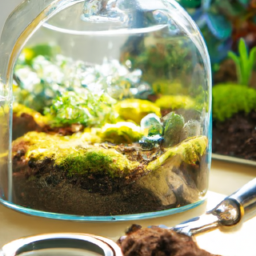
Choosing the Right Plants for Your DIY Terrarium: Tips and Recommendations for Creating a Thriving Mini Ecosystem
Introduction
Creating a DIY terrarium is an excellent way to bring a touch of nature into your living space. These miniature ecosystems are not only visually appealing but also require minimal maintenance. One of the crucial aspects of building a successful terrarium is selecting the right plants. In this guide, we will explore some tips and recommendations to help you choose the perfect plants for your DIY terrarium project.
Understanding Terrarium Plants
Before diving into the selection process, it’s important to understand the characteristics of plants that thrive in terrariums. Terrarium plants should be able to adapt to the enclosed environment and the limited space available. They should also have similar moisture and light requirements to ensure harmonious growth within the mini ecosystem.
1. Consider the Terrarium Type
There are two main types of terrariums: open and closed. Open terrariums have better airflow and lower humidity levels, making them suitable for plants that prefer drier conditions, such as succulents and cacti. Closed terrariums, on the other hand, trap moisture and create a more humid environment, making them ideal for plants that thrive in high humidity, like ferns and mosses. Understanding the type of terrarium you want to create will help you narrow down your plant choices.
2. Size and Growth Habit
When selecting plants for your terrarium, consider their size and growth habit. Since terrariums have limited space, it’s best to choose plants that stay small or have a slow growth rate. Compact plants like air plants, baby’s tears, and miniature ferns are great choices for small terrariums. If you have a larger terrarium, you can opt for slightly taller plants like fittonias or nerve plants.
3. Light Requirements
Different plants have varying light requirements, so it’s crucial to consider the lighting conditions in the area where you plan to place your terrarium. If your terrarium will be situated in a bright room with ample natural light, you can choose plants that thrive in medium to high light conditions, such as pothos or spider plants. For terrariums placed in low-light areas, consider plants that can tolerate lower light levels, like ferns or peace lilies. It’s important to strike a balance and avoid exposing your terrarium to direct sunlight, as it can lead to excessive heat and damage the plants.
Recommendations for Terrarium Plants
Now that you have a better understanding of what to look for in terrarium plants, let’s explore some recommendations that are known to thrive in these miniature ecosystems.
1. Air Plants (Tillandsia spp.)
Air plants are incredibly popular for terrariums due to their unique appearance and minimal care requirements. They don’t require soil and absorb nutrients and moisture from the air. These plants can be attached to driftwood or placed in small containers within the terrarium. They prefer bright, indirect light and occasional misting.
2. Baby’s Tears (Soleirolia soleirolii)
Baby’s Tears, also known as mind-your-own-business, are delicate, low-growing plants that create a lush carpet-like effect in terrariums. They thrive in high humidity and prefer indirect light. Baby’s Tears require regular misting or watering to maintain moisture levels.
3. Fittonia (Fittonia spp.)
Fittonia, commonly known as nerve plants, are stunning with their vibrant and colorful foliage. They prefer medium to bright indirect light and high humidity. Fittonias can be a bit more demanding when it comes to moisture, so misting or a pebble tray to increase humidity levels may be necessary.
4. Ferns (Various Species)
Ferns are classic choices for terrariums due to their love for moisture and shade. They come in various sizes and shapes, including the popular maidenhair fern and bird’s nest fern. Ferns require indirect light and consistently moist soil to thrive.
5. Mosses (Various Species)
Mosses are excellent additions to terrariums as they create a lush and natural look. They prefer high humidity and low to medium light conditions. Mosses require occasional misting or watering to maintain moisture levels.
Conclusion
Choosing the right plants for your DIY terrarium is essential for creating a thriving mini ecosystem. By considering the terrarium type, size and growth habit of plants, as well as their light requirements, you can select the perfect plants that will flourish within the enclosed environment. Remember to research each plant’s specific care needs and enjoy the process of building your own unique terrarium. With the right plants and a little care, you’ll have a beautiful and captivating mini ecosystem to enjoy in your home or office.
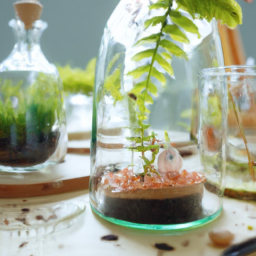
3. Creative Ideas for DIY Terrarium Designs: From Hanging Terrariums to Succulent Gardens
Introduction
Welcome to the exciting world of DIY terrariums! Building mini ecosystems with plants is not only a fun and creative hobby but also a great way to bring a touch of nature into your home or office. In this guide, we will explore various creative ideas for DIY terrarium designs, from hanging terrariums to succulent gardens. Whether you are a beginner or an experienced terrarium enthusiast, these ideas will inspire you to create stunning and unique terrariums that will be the envy of all your friends.
Hanging Terrariums
If you’re looking to add a whimsical and eye-catching element to your terrarium, hanging terrariums are the way to go. These suspended mini ecosystems not only create a stunning visual display but also save space and add a unique touch to any room. Here are some steps to create your own hanging terrarium:
Step 1: Choose the Right Container
The first step in creating a hanging terrarium is to choose the right container. Opt for a glass container with a hook or loop at the top for easy hanging. You can find a variety of shapes and sizes, from traditional round globes to geometric shapes and even teardrop designs. Ensure that the container has a wide enough opening to allow easy access for planting and maintenance.
Step 2: Gather Your Materials
Once you have your container, gather all the materials you’ll need for your hanging terrarium. This includes small pebbles or gravel for drainage, activated charcoal to keep the terrarium fresh, potting soil suitable for your chosen plants, and of course, the plants themselves. Choose plants that thrive in humid environments and don’t require direct sunlight, such as ferns, mosses, and air plants.
Step 3: Assemble Your Terrarium
Now it’s time to assemble your hanging terrarium. Start by adding a layer of small pebbles or gravel at the bottom of the container to ensure proper drainage. Next, add a thin layer of activated charcoal to help keep the terrarium fresh by absorbing excess moisture and odors. Then, carefully add the potting soil, making sure to create a suitable environment for your chosen plants. Finally, plant your selected plants, arranging them in an aesthetically pleasing way.
Step 4: Hang and Maintain
Once your hanging terrarium is assembled, find the perfect spot to hang it. Choose a location that receives indirect sunlight and is easily accessible for maintenance. Remember to mist the terrarium with water every few days to maintain the humidity levels necessary for your plants’ well-being. Additionally, keep an eye on the moisture levels in the soil and water accordingly.
Succulent Gardens
If you prefer a low-maintenance terrarium that adds a touch of desert charm to your space, a succulent garden is an excellent choice. Succulents are known for their ability to store water in their leaves, making them perfect for dry environments. Here’s how you can create your own succulent garden:
Step 1: Select the Right Container
When it comes to succulent gardens, the container plays a crucial role. Opt for a shallow container with good drainage to prevent waterlogging. You can choose a classic terracotta pot, a wooden planter, or even repurpose an old teacup or a vintage tin. Get creative and let your personal style shine through the choice of container.
Step 2: Prepare the Soil
Succulents require well-draining soil to thrive. You can either purchase a pre-mixed succulent soil or create your own by combining regular potting soil with coarse sand or perlite. This mixture allows excess water to drain quickly, preventing root rot.
Step 3: Choose and Plant Your Succulents
Now comes the fun part – selecting and planting your succulents. Choose a variety of shapes, colors, and sizes to create an interesting visual display. Some popular succulents include Echeverias, Aloe Vera, and Haworthias. Gently remove the succulents from their nursery pots, loosen the roots, and plant them in the prepared soil. Ensure that the soil is firmly packed around the roots to provide stability.
Step 4: Care and Maintenance
Succulents are relatively low-maintenance plants, but they still require some care to thrive. Place your succulent garden in a location that receives bright, indirect sunlight. Water sparingly, allowing the soil to dry out completely between waterings. Overwatering can lead to root rot, so it’s better to underwater than overwater. Additionally, fertilize your succulents once or twice a year with a balanced, water-soluble fertilizer.
Conclusion
Creating DIY terrariums is a fantastic way to unleash your creativity and add a touch of nature to your surroundings. Whether you opt for hanging terrariums that float in mid-air or succulent gardens that bring desert vibes indoors, these unique designs will surely impress. Remember to choose the right container, gather the necessary materials, and follow the step-by-step instructions to build your own mini ecosystem. With a little care and maintenance, your DIY terrarium will thrive and become a beautiful focal point in your home or office.
Let’s recap
Terrariums are all the rage right now, and for good reason! These miniature ecosystems bring a touch of nature into any space, and the best part is, you can easily build one yourself. Whether you have a green thumb or not, DIY terrariums are a fun and rewarding project that allows you to create a unique and low-maintenance garden.
To start building your own terrarium, you’ll need a few basic materials: a glass container, gravel or pebbles for drainage, activated charcoal to keep the soil fresh, potting soil, and of course, the star of the show – plants! Choose plants that thrive in humid environments and don’t require too much direct sunlight, such as ferns, mosses, or succulents. Once you have your materials ready, it’s time to get creative! Layer the bottom of your container with gravel, followed by a thin layer of activated charcoal. This will ensure proper drainage and prevent any unpleasant odors. Then, add a layer of potting soil, making sure it’s deep enough for your plants’ roots. Now comes the fun part – arranging your plants! Experiment with different shapes, sizes, and textures to create a visually pleasing composition. Finally, give your terrarium a light misting of water and place it in a spot with indirect sunlight. Remember to monitor the moisture levels and water sparingly, as terrariums are self-contained ecosystems that recycle their own water. With a little love and care, your DIY terrarium will thrive and become a beautiful addition to your home or office. So why not give it a try and enjoy the benefits of having your own mini garden?
Curious Minds Asked, We Responded. Frequently Asked Questions:
Q1: What is a terrarium?
A1: A terrarium is a small, enclosed ecosystem that can be created in a glass container. It typically consists of plants, soil, and sometimes decorative elements like rocks or figurines. The enclosed environment allows for the circulation of water and air, creating a self-sustaining mini ecosystem.
Q2: How do I build a DIY terrarium?
A2: Building a DIY terrarium is relatively simple and requires a few basic steps. First, choose a suitable glass container with a lid or cover. Next, add a layer of gravel or pebbles at the bottom to provide drainage. Then, add a layer of activated charcoal to help filter the air. After that, add a layer of potting soil and arrange your chosen plants inside. Finally, add any decorative elements and lightly mist the terrarium with water. Close the lid and place it in a well-lit area, but away from direct sunlight.
Q3: What plants are suitable for terrariums?
A3: Terrariums are ideal for plants that thrive in humid environments and low light conditions. Some popular choices include ferns, mosses, air plants, and succulents. It’s important to choose plants that have similar light and water requirements to ensure they can coexist within the enclosed ecosystem.
Q4: How do I care for a terrarium?
A4: Terrariums require minimal care, but there are a few key things to keep in mind. Firstly, monitor the moisture levels inside the terrarium and mist it with water when needed to maintain a slightly humid environment. However, be careful not to overwater, as excessive moisture can lead to mold or root rot. Secondly, ensure the terrarium receives indirect sunlight or bright, filtered light. Lastly, periodically remove any dead leaves or plants to maintain the overall health and appearance of the terrarium.
Q5: Can I create different types of terrariums?
A5: Absolutely! Terrariums offer endless possibilities for creativity. You can experiment with different container shapes and sizes, as well as various plant combinations. Some popular variations include desert terrariums, fairy gardens, and aquatic terrariums. The key is to choose plants and elements that suit the specific environment you want to create within the terrarium.

Lisa Chen is a seasoned indoor gardening expert and the author of several bestselling books on the topic. With a background in horticulture and urban farming, Lisa is dedicated to helping urban dwellers embrace the joys of cultivating green spaces indoors. Her detailed guides and hands-on tips empower readers to transform their living spaces into thriving plant sanctuaries.

